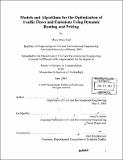| dc.contributor.advisor | Ismail Chabini. | en_US |
| dc.contributor.author | Abou Zeid, Maya, 1979- | en_US |
| dc.contributor.other | Massachusetts Institute of Technology. Dept. of Civil and Environmental Engineering. | en_US |
| dc.date.accessioned | 2006-03-24T16:03:00Z | |
| dc.date.available | 2006-03-24T16:03:00Z | |
| dc.date.copyright | 2003 | en_US |
| dc.date.issued | 2003 | en_US |
| dc.identifier.uri | http://hdl.handle.net/1721.1/29567 | |
| dc.description | Thesis (S.M.)--Massachusetts Institute of Technology, Dept. of Civil and Environmental Engineering, 2003. | en_US |
| dc.description | Includes bibliographical references (p. 181-189). | en_US |
| dc.description.abstract | The research documented in this thesis is centered on the development and evaluation of models and algorithms for the optimization of traffic flows and emissions via routing and pricing in dynamic traffic networks. A set of problems that arise in this context are studied. These include: (1) the development of a probabilistic approach to model acceleration, (2) the study of the dynamic capacitated minimum cost flow problem, (3) an experimental analysis of improvements in shortest path algorithms, and (4) the study of dynamic congestion and emission pricing. We propose a probabilistic approach for modeling accelerations and decelerations in traffic networks as random variables that are a function of speed and road type. We use the approach to integrate a non-microscopic dynamic traffic model and an instantaneous emission model. We develop routing algorithms that can be used in the context of traffic flow optimization. First, we study the capacitated minimum cost flow problem in dynamic traffic networks, and develop two solution algorithms for the problem. The developed algorithms are shown experimentally to be more efficient than an existing algorithm in the literature. Second, we perform experimental testing to assess the computational performance of a new approach to solve the shortest path problem in static and dynamic FIFO networks, that tries to overcome some of the limitations in traditional comparison-based label-setting algorithms. Finally, we develop a second-best link-based dynamic congestion pricing model and formulate it as a bi-level program. We develop solution algorithms based on sensitivity analysis, and model both route and departure time choices as users' reaction to the prices. We extend the model and algorithms to study emission pricing. Finally, we formulate the model with additional travel time or emissions constraints, and evaluate the effectiveness of the pricing methods on small hypothetical network examples. | en_US |
| dc.description.statementofresponsibility | by Maya Abou Zeid. | en_US |
| dc.format.extent | 207 p. | en_US |
| dc.format.extent | 7922996 bytes | |
| dc.format.extent | 7922803 bytes | |
| dc.format.mimetype | application/pdf | |
| dc.format.mimetype | application/pdf | |
| dc.language.iso | eng | en_US |
| dc.publisher | Massachusetts Institute of Technology | en_US |
| dc.rights | M.I.T. theses are protected by copyright. They may be viewed from this source for any purpose, but reproduction or distribution in any format is prohibited without written permission. See provided URL for inquiries about permission. | en_US |
| dc.rights.uri | http://dspace.mit.edu/handle/1721.1/7582 | |
| dc.subject | Civil and Environmental Engineering. | en_US |
| dc.title | Models and algorithms for the optimization of traffic flows and emissions using dynamic routing and pricing | en_US |
| dc.type | Thesis | en_US |
| dc.description.degree | S.M. | en_US |
| dc.contributor.department | Massachusetts Institute of Technology. Department of Civil and Environmental Engineering | |
| dc.identifier.oclc | 52733944 | en_US |
